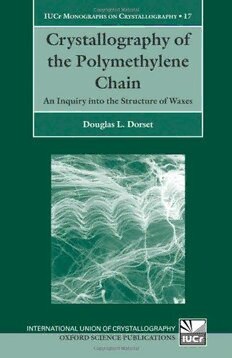
Crystallography of the Polymethylene Chain: An Inquiry into the Structure of Waxes (International Union of Crystallography Monographs on Crystallography) PDF
245 Pages·2005·3.482 MB·English
Most books are stored in the elastic cloud where traffic is expensive. For this reason, we have a limit on daily download.
Preview Crystallography of the Polymethylene Chain: An Inquiry into the Structure of Waxes (International Union of Crystallography Monographs on Crystallography)
Description:
By considering the solid state packing of linear chain wax components, this book aims at understanding three things: firstly, which modifications of molecular components are allowed for maintaining stable solid solutions; secondly, what happens when stability conditions are traversed and fractionation begins and thirdly, the structure of fractionated arrays. The co-compatibility of molecular ingredients is considered in terms of their shapes and relative sizes, following an approach originally proposed by Kitaigorodskii. As demonstrated profusely by the crystal structures of pure component types (e. g. alkanes, fatty alcohols, fatty acids, long chain esters, cholesteryl esters) and insertion of functional groups (e. g. chain branches, unsaturation, heteroatoms), characteristic molecular packing arrays provide important geometric information for understanding the co-packing of different molecules in mixtures. Single crystal and spectroscopic data from polydisperse arrays can then be evaluated to arrive at plausible structures of solid solutions and fractionated systems. The resultant structures are not only relevant to the understanding of so-called waxes but also include certain classes of polymers. The ramifications of this work extend into any solid state array of polymethylene chains, including lipid foodstuffs.
See more
The list of books you might like
Most books are stored in the elastic cloud where traffic is expensive. For this reason, we have a limit on daily download.
